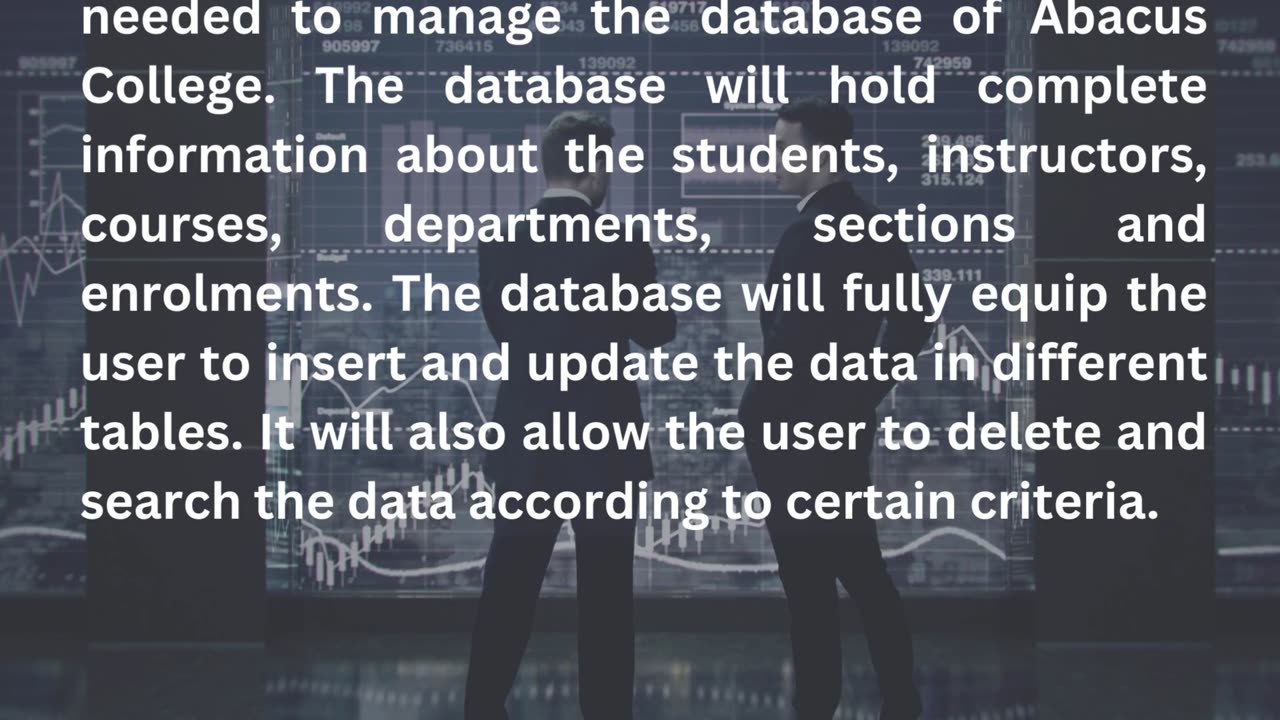Premium Only Content

Data Structures: Data Management with CSC-221 Data Structures Lab Assignment B
Data Structures: Data Management CSC-221 Data Structures Assignment
The "HND SEC4205 Database Design and Development Assignment: Personal DVD Library" is a pivotal undertaking in the realm of Higher National Diploma (HND) studies, specifically for students enrolled in the SEC4205 course. This comprehensive assignment immerses students in the intricacies of database design and development, offering them a hands-on opportunity to construct a database tailored to a real-world scenario—a personal DVD library. The assignment commences with the creation of an Entity-Relationship (ER) diagram, serving as the foundational blueprint for the entire database design process. The crux of this assignment revolves around the ER diagram, an indispensable tool in database design. Students are tasked with crafting a visual representation that delineates the essential entities within the personal DVD library, defining their attributes and specifying the relationships that exist between them. This critical step bridges the theoretical concepts learned throughout the SEC4205 course with practical application, enabling students to conceptualize the structure of their database. Entities mapping is another pivotal phase of this assignment, wherein students translate the abstract entities outlined in the ER diagram into tangible database tables. Query design is another critical facet of this assignment. Students are encouraged to create meaningful and effective queries that align with the library's requirements.
Table of Contents
Table of Figures:
1.1 Explain the issues organizations must consider when planning computer systems maintenance.
Organisational policy and procedures
Sustainability and environmental issues
Reporting, documentation and problem escalating procedures
Employee and employer responsibilities
Legislation: Health and safety
Legislation: Portable appliance testing (PAT)
1.2 Access the health and safety risks facing the practitioner when maintaining computer systems
Health and safety
Precautions and safety equipment
LO1: Use appropriate design tool to design relational database system:
1.1. Identify the Role of Database Systems:
1.1.1. Data access within the company:
1.1.2. Maintain Strong relationships between data:
1.1.3. Newer and Better Updates:
1.1.4. Search data in a better manner:
1.2. Determine user and system requirments:
1.3. Design Tools and Techniques for relational database:
1.3.1. Important Phases of Database Designing:
1.3.2. Important Database Designing Tools:
1.4. Logical Design for Relational Database:
1.4.1. Entity Relationship diagrams:
1.4.2. Relational Schema:
1.4.3. MySQL commands to design:
1.5. Designs for Data Integrity, Data Validation, Data Security and Data Controls:
1.5.1. Data Integrity:
1.5.2. Data Validation:
1.5.3. Data Security:
1.6. User Interface Design:
1.7. Output designs for user requirements:
1.8. Overview of object-oriented databases and their design tools:
Task 2:
LO2: Development of Functional Relational Database System:
2.1. Consideration of Different database development platform options for system development:
2.1.1. Microsoft:
2.1.2. Oracle:
2.1.3. IBM:
2.1.4. Google:
2.2. – 2.11. Application Development and Design:
2.2.1. Types of Users:
LO3: Testing the system for requirements:
Task 3:
3.1. Identify elements of the system that need to be tested:
3.1.1. Data Mapping:
3.1.2. ACID properties validation:
3.1.3. Data integrity:
3.1.4. Business Rule Conformity:
3.2 - 3.5. Consider data that should be used to fully test the system:
3.2.1. Transactions:
3.2.2. Database Schemas:
3.2.3. Triggers:
3.2.4. Stored Procedures:
3.2.5. Field Constraints:
Task 4:
LO4: Technical and user documentation and their contents:
4.1. Workflow:
4.2. Performing different operations:
References:
Table of Figures:
Figure 1.0‑1: E-R Diagram
Figure 1.0‑2: Relational Schema
Figure 1.0‑3: Courses Table
Figure 1.0‑4 Departments Table
Figure 1.0‑5: Instructors Table
Figure 1.0‑6: Sections Table
Figure 1.0‑7: Students Table
Figure 1.0‑8: Users Table
Figure 2.0‑1: Admin Panel
Figure 2.0‑2: The Student Search
Figure 2.0‑3: The Teacher’s Search
Figure 2.0‑4: The Section Search
Figure 2.0‑5: The Department Search
Figure 2.0‑6: The Courses Search
Figure 2.0‑7: The Student List
Figure 2.0‑8: The Teacher’s List
Figure 2.0‑9: The Sections List
Figure 2.0‑10: The Department Search
Figure 2.0‑11: The Courses List
Figure 2.0‑12: Adding a User
Figure 2.0‑13: Adding Student or Teacher Details
Figure 2.0‑14: Adding a New Section
Figure 2.0‑15: Adding a new course
Figure 3.0‑1: Database Testing ACID
Figure 4.0‑1: The Workflow
Figure 4.0‑2: Searching Data
Figure 4.0‑3: Listing Data
Figure 4.0‑4Figure 4.3: Adding Data
For Complete Free Assignments Like these visit our Website:
https://tasks24.com
-
 1:09:59
1:09:59
Geeks + Gamers
6 hours agoSonic 3 DESTROYS Mufasa And Disney, Naughty Dog Actress SLAMS Gamers Over Intergalactic
60.1K9 -
 51:59
51:59
The Dan Bongino Show
7 hours agoDemocrat Donor Admits The Scary Truth (Ep. 2393) - 12/23/2024
692K2.04K -
 2:32:15
2:32:15
Matt Kohrs
18 hours agoRumble CEO Chris Pavlovski Talks $775M Tether Partnership || The MK Show
104K29 -
 28:23
28:23
Dave Portnoy
18 hours agoDavey Day Trader Presented by Kraken - December 23, 2024
138K37 -
 59:29
59:29
BonginoReport
9 hours agoTrump, Murder Plots, and the Christmas Miracle: Evita + Jack Posobiec (Ep.110) - 12/23/2024
148K125 -
 2:59:14
2:59:14
Wendy Bell Radio
11 hours agoNothing To See Here
120K70 -
 2:12:18
2:12:18
TheDozenPodcast
1 day agoIslam vs Christianity: Bob of Speakers' Corner
108K26 -
 14:36
14:36
The StoneZONE with Roger Stone
1 day agoRoger Stone Delivers Riveting Speech at Turning Point’s AMFEST 2024 | FULL SPEECH
129K31 -
 18:59
18:59
Fit'n Fire
17 hours ago $8.46 earnedZenith ZF5 The Best MP5 Clone available
89.2K4 -
 58:34
58:34
Rethinking the Dollar
1 day agoTrump Faces 'Big Mess' Ahead | RTD News Update
63.8K6